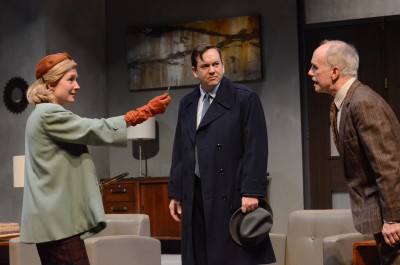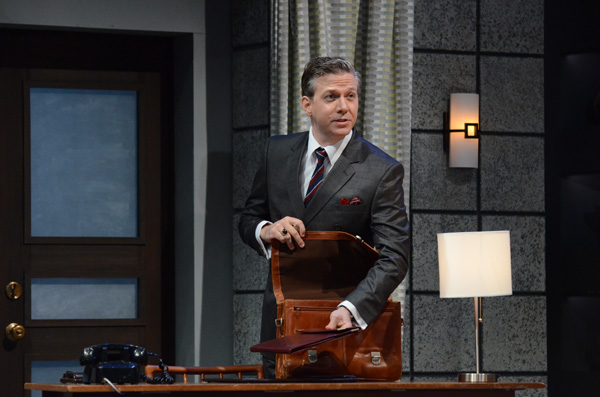There’s no such thing as the perfect crime—but that never stopped Alfred Hitchcock. The legendary English film director and producer practically invented the thriller, crafting the kind of creepy-yet-compelling crime voyeurism that kept film audiences on the edge of their seats.
And while Hitchcock didn’t write “Dial ‘M’ For Murder”— English playwright Frederick Knott wrote the screenplay and successful stage play on which it was based—his cool, sexy cinematic style is part of the picture when Olney Theatre Center (OTC) stages its tightly-coiled stage version of the classic.
“When I started watching some of Hitchcock’s films, I was expecting them to be old-fashioned,” admitted OTC’s Associate Artistic Director Jason King Jones, who is directing the play. “But I learned not to take these old movies for granted. ‘Dial ‘M’ For Murder’ is really steamy at times—the heat, the sexual tension. It’s deadly!”

And just as modern audiences go gaga for similarly “deadly” crime conundrums like “Making a Murderer” and “Serial,” Jones believes the revisited Hitchcock classic will attract an avid following. “We’re drawn to crime dramas,” he said. “Trying to understand the mind of a killer…We see ourselves in those stories, and we relate to those characters. They may go left when we go right, but still, it’s a sexy story.”
Money, marriage and murder—that’s the golden triangle at the heart of this plot. Jones was quick to point out that Dial ‘M’ is a thriller, not a whodunit. The audience knows who done it, and they know why. “The human story resonates: love, jealousy, revenge,” Jones explained. “And those themes are universal. But somebody trying to get away with something, to beat the system, to use his or her evil genius? That we love watching.”
And not just watching, in this case, but also listening to. “The subtitle of ‘Dial ‘M’ For Murder’ is ‘A Collage for Voices,’” Jones said. “Offstage voices, characters on the phone, footsteps in the hallway: everything that’s outside this little world we’ve created on stage, well, if we don’t see it, we hear it.”
And Jones went back to the start with this production, incorporating the sleek, cool “Mad Men” feel of Hitchcock, sure, but also offering an insight to the origins of the story by recreating the tight little world of the original Knott play.
“Dial ‘M’ started as a teleplay written for the BBC, then was made into a stage play,” explained legendary movie critic Arch Campbell. “It’s one of the few plays Hitchcock adapted.”
Campbell, who has reported on movies, theater, entertainment and the arts since the 1970s (and joined Jones for a panel discussion April 9 on how “Dial ‘M’ for Murder” contributes to Hitchcock’s legacy and the differences between the film and the play on which it’s based) offers some intriguing insight to the making of the film.
“Hitchcock made Dial ‘M’ at the end of the 3-D craze,” Campbell notes. “Of all of his material, this is the most compact—set in an apartment with a garden and a street scene—and he elected not to open it up.”

For Campbell, Dial ‘M’ features an important characteristic that most of Hitchcock’s stories share. “The audience knows what’s coming,” he said. “The characters don’t. The wife doesn’t know she’s being set up to be murdered by her husband’s unsavory friend—Hitchcock liked to do that. He let us in on what was happening to the characters.”
The suspense, then, would rest in the audience’s relationship to the characters, a relationship Hitchcock cemented with what Campbell called “the God’s-eye view. “In the film, the camera would sometimes take the point of view of the character we’re concerned with,” he explained. “We won’t get the God’s-eye view watching Dial ‘M’ as a stage play, but it’s a way Hitchcock used technique. You’re in on it; you’re wondering, ‘How does this come out?’
“He still has a big reveal. It’s a lovely jigsaw—and it probably works best onstage.”
Jones agreed. “I was studying these films to see: What are the commonalities? What are the elements all thrillers have in common?
How did Hitchcock establish suspense?”
And while he admitted to being “a Shakespeare guy” who loves language-based plays, Jones grew to admire the spare, not-a-word-wasted style of Knott’s script—and to imagine the design elements that would add to the suspense.
“Charlie Calvert is our set designer, and movies like ‘Rear Window’ and ‘North by Northwest’ played strongly into our design choices,” said Jones. “Being able to voyeuristically look into what’s happening in someone else’s home…knowing when there’s someone on the other side of the door—those things have been very much our focus.”
So the God’s-eye view shifts from the lens of Hitchcock to the edge of the theater seat, exactly where Jones wants it to be. “All of the characters in this story like to play with fire,” he said. “They all know the rules, but are trying to live outside them somehow.” And everyone knows how that goes.
“Dial ‘M’ for Murder” runs through May 1 on the OTC Mainstage. For tickets, call 301-924-3400 or visit www.olneytheatre.org.
Photo Credit (all photos): Stan Barouh